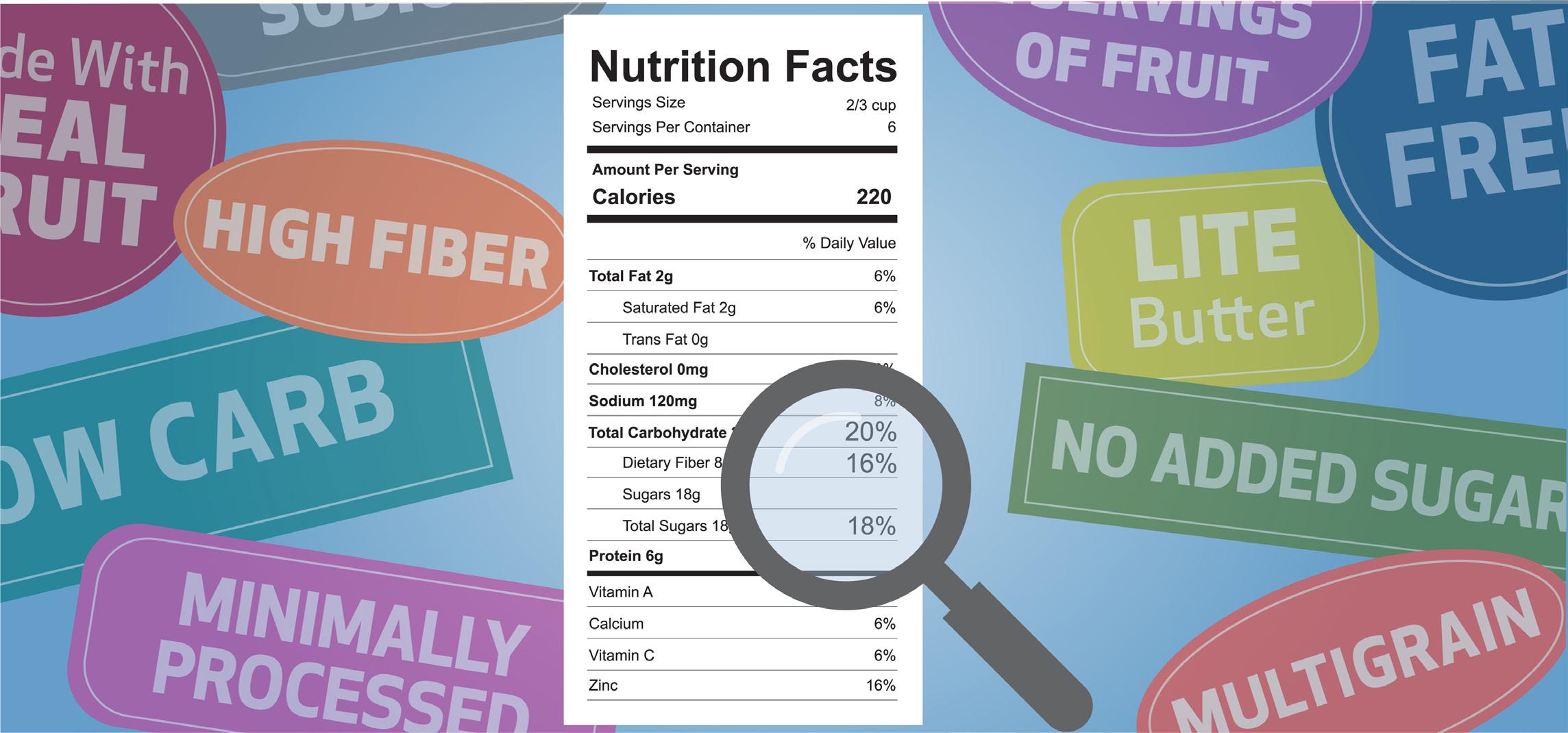




In every grocery store aisle, packaged food labels claim a host of health benefits: Fat free, reduced sodium, low carb — the list goes on. But what do these statements really mean for your health?
According to dietitian experts at Houston Methodist, five easy tips can help you make healthier food choices, despite the confusing labels.
Almost 60% of the average American’s calories come from processed foods. Choose fruits, vegetables, whole grains, lean meats and healthy fats (such as avocados) that provide the nutrients your body needs to function optimally.
You don’t need to eliminate processed food entirely. Instead, try to choose healthy options whenever possible and pay attention to the serving size on your food label. This will help you avoid the most misleading terms, including:
■ Fat Free or Sugar Free: “Free” doesn’t mean there isn’t any fat or sugar in the food. What it actually means is that there is 0.5 grams or less in the food. Make sure to read the serving size —those grams can add up quicker than you realize.
■ Reduced Sodium or Reduced Sugar: On a food label, “reduced” does not mean there is less salt or sugar. What it means is that the product contains at least 25% less salt or sugar compared to the regular version of the same food. Instead, choose a low-salt or low-sugar alternative.
■ “X” Servings of Fruit: If you don’t see real fruit in the ingredients list, the product doesn’t contain the nutrition of real fruit and likely is high in calories and sugar. A better choice would be fresh or frozen fruits with natural sugars.
3. AVOID TRANS FATS
Trace amounts of trans fats occur naturally in foods, but processed foods are often loaded with it. You really should try to limit this type of fat because studies suggest it can increase the risk of heart disease through high cholesterol.
4. GET PLENTY OF FIBER
Fiber is good for you, but it is normal to have gas and bloating with it as part of the digestion process. To combat this, eat high-fiber foods a little at a time throughout the course of the day instead of in one large meal.
Look for the words “whole grain” on the label. “Multigrain” or “enriched” is not the same thing. Whole grains are healthier and include whole wheat, corn and oats. •


If your first few steps out of bed cause stabbing pain, you may be experiencing plantar fasciitis.
“Plantar fasciitis is one of the most common foot orthopedic complaints and the most common cause of heel pain,” said Dr. Gurpreet Mukker, a podiatrist at Houston Methodist The Woodlands Hospital.
The plantar fascia is a stretchy band of connective tissue that connects the heel to the ball of your foot and toes, encircling the bones to help support the arch. It is a shock absorber and can endure significant wear and tear over time.
Plantar fasciitis is a painful inflammation of the plantar fascia, often caused by microtears.
“Patients describe sharp or stabbing heel pain with their first steps in the morning, but also after a short period of rest, called post-static dyskinesia (tightening of the plantar fascia when the foot is in a nonweightbearing state),” Mukker explained.
It’s viewed as a temporary issue, primarily among athletes, those who are increasing their physical activity after an extended break, or runners enhancing their mileage for a long-distance race.
Anyone can develop plantar fasciitis, and your risk increases after age 40. And, if you’ve experienced heel pain in the past, you’re more likely to experience the condition again.
Tips to prevent plantar fasciitis include:
Scan this QR code to take a quiz and find out.
■ Replacing old, broken-down running shoes with a new pair
■ Wearing supportive shoes or shoe inserts
■ Starting a new exercise slowly and building intensity gradually
■ Adding rest, warmups and cooldowns into your movement routine
“Stretching is the number one daily habit to prevent plantar
fasciitis,” Mukker said. “It is especially important to stretch the calf muscle as it stretches the plantar fascial bands as well.”
Plantar fasciitis does require treatment, but it doesn’t usually involve surgery.
“Conservative treatments, such as stretching both your calf and plantar fascia, gentle massage, icing your arches by rolling your foot over a frozen water bottle, and wearing supportive shoes, are effective,” Mukker added.
Resting and taking breaks from high-intensity exercise are essential for healing. If you’re active, choose low-impact exercises like cycling or swimming to prevent overworking the plantar fascia.
“Taping your own injuries won’t work for plantar fasciitis,” Mukker noted. “I suggest a night splint or brace that keeps your foot stretched during the night to jumpstart your pain relief first thing in the morning.”
You should also avoid wearing thin shoes without support, such as flip-flops. Being barefoot for prolonged periods can also worsen pain. If your pain lingers, you may consider physical therapy or other non-surgical treatments, but for most, the conservative approach will alleviate the pain. See a foot and ankle specialist if symptoms persist after a year of treatment. •
Is your heel pain keeping you from enjoying your life? Our foot and ankle specialists can help. To make an appointment, visit houstonmethodist.org/orthowoodlands or call 936.321.8000.

Every day, new research suggests breast cancer may be more preventable than experts once thought.
“While there are cancer risk factors such as age and family history that are outside of your control, you can control your lifestyle,” said Dr. Karen Louie, breast surgeon at Houston Methodist Neal Cancer Center at The Woodlands. “If you want to reduce your breast cancer risk, make changes that have a significant impact.”
Here are the top lifestyle changes to reduce your chances for developing breast cancer:
One of the most overlooked risk factors for breast cancer is weight gain after menopause. Having a high body mass index (BMI) post-menopause can significantly increase a woman’s risk of breast cancer — anywhere from 20% to 60%.
“Women can gain weight in menopause due to changing metabolism, and that excess weight leads to higher estrogen levels,” Louie explained. “After menopause, your estrogen is made in fat cells. So having extra fat cells means extra estrogen, which increases your risk for breast cancer.”
The American Cancer Society recommends 300 minutes of moderate exercise weekly to help reduce cancer risk, which breaks down to about 42 minutes each day. This can include low-impact activities such as brisk walking, cycling, Pilates or swimming. If you’re up for vigorous activities — think jogging, playing tennis, jumping rope or taking a HIIT class — then that overall number drops down to just 22 minutes each day.
“Moderate to vigorous activity not only helps in managing weight and reducing your cancer risk, but also boosts your overall health,” Louie added.
Alcohol intake is another often underestimated cancer risk factor. Many people enjoy a glass of wine with dinner or a drink at social events, but regular alcohol consumption is strongly associated with increasing your risk of developing breast cancer.
“The national recommendation is no alcohol for prevention, however, one drink a few days a week is reasonable,” Louie said. Also, taking a daily multivitamin with folate or a folic acid supplement may mitigate breast cancer risk associated with alcohol consumption.
For many women, hormone replacement therapy (HRT) is a common treatment to manage menopause symptoms but knowing
where to start and how HRT will impact your breast cancer risk is important.
“Hormone replacement therapy (HRT) is a serious discussion for each woman to have with her doctor — usually her gynecologist or primary care physician — due to the increased risk that HRT presents for breast cancer,” Louie explained. “Hormone replacement is helpful for menopause symptoms such as weight gain, bone density loss, hot flashes and insomnia, but make sure you talk to a doctor about risks first.”
Even if you follow all of this advice, every woman has at least a 12% risk of developing breast cancer, which is why it is extremely important to have screening tests, such as an annual mammogram beginning at age 40. Mammography is still the most effective tool to diagnose early-stage breast cancer, before tumors are large enough to feel or cause symptoms. •

Every woman is different, and your treatment should be tailored to your specific health needs. If you or a loved one has been diagnosed with breast cancer and would like to schedule an appointment, visit houstonmethodist.org/breast-cancer-hmtw or call 713.790.2700
To schedule your mammogram at a Houston Methodist Breast Care Center, visit houstonmethodist.org/mammogram-scheduling or call 346.356.PINK (7465)

The longer a woman breastfeeds, the greater the protective effect for fighting breast cancer. While the reasons behind the risk reduction aren’t clear, one possible explanation is that women who breastfeed have fewer menstrual cycles throughout their lives, and, therefore, less estrogen exposure.
Additional ways a woman can reduce her breast cancer risk

Studies indicate a diet rich in monounsaturated fats such as olive oil may protect against breast cancer, too. Olive oil also contains antioxidants and anti-inflammatory properties, both of which can help reduce breast cancer risk.

Your doctor may recommend tamoxifen and raloxifene medications if you're at an increased risk for breast cancer. Since these medications can produce menopause symptoms, talk to your doctor about the risks and benefits.

If you have a strong family history of breast cancer, ask your doctor if genetic testing is right for you. Mutations in certain genes, such as BRCA1 and BRCA2 genes, increase breast cancer risk. Women with this gene mutation may have more frequent screenings or prophylactic surgery (breast removal).


If you’re experiencing poor sleep or snoring that disturbs everyone in your home, you could have obstructive sleep apnea. Untreated sleep apnea may result in severe health issues, including high blood pressure, type 2 diabetes, heart disease and stroke.
“Don’t underestimate sleep apnea,” said Dr. Daniel Strigenz, an otolaryngologist with Houston Methodist The Woodlands Hospital. “Beyond sleep and relationships, it is a ‘silent killer.’ If you have it, treatment is critical.”
Untreated sleep apnea can lead to serious health problems, including:
■ Heart disease and heart attack
■ High blood pressure
■ Metabolic syndrome
■ Nonalcoholic fatty liver disease
■ Stroke
■ Type 2 diabetes
Depending on your condition, sleep apnea treats can vary from breathing machines to surgical options. Strigenz addressed a few common questions about your treatment alternatives.
HOW
“Usually, the first treatment we try for sleep apnea is a CPAP (continuous positive airway pressure) machine,” Strigenz explained. “It works by helping you breathe more regularly every night while you sleep.”
As the machine works, it delivers oxygen into your nose and mouth via a mask. This air keeps your airway open, preventing any interruptions in your breathing.
This type of treatment can reduce your risk of chronic health conditions and improve sleep and daytime productivity. Some people find wearing the mask uncomfortable throughout the night, but it’s necessary to gain the full benefits.
If you’re not comfortable with a CPAP machine or have a more severe form of sleep apnea, you might consider sleep surgery.
The type of surgery will vary depending on your specific airway blockage.
To identify the site of obstruction, most airway exams are performed in the office. If needed, the airway is assessed with a sleep endoscopy in the operating room.
“Depending on a patient’s specific anatomy, a variety of surgical options may be employed to relieve obstruction and help patients get off CPAP or tolerate it better,” Strigenz shared.
For individuals who wish to avoid a CPAP machine, there is a new, less-invasive option for treating moderate to severe sleep apnea.
“A hypoglossal nerve stimulator is an alternative to traditional sleep surgery for some sleep apnea patients,” Strigenz explained.
“This treatment uses a device to stimulate the hypoglossal nerve, the nerve responsible for controlling multiple muscles in your tongue.”
This device, implanted in the upper chest with just two small incisions, is activated only during sleep. It detects respiration and stimulates your hypoglossal nerve with each breath, pushing your tongue forward to open your airway.
To be eligible for a hypoglossal nerve stimulator you must have:
■ A BMI less than 40
■ Obstruction that occurs at the palate or base of the tongue
■ Sleep apnea that’s moderate to severe (not mild)
“When patients meet the specific criteria, the hypoglossal nerve stimulator is remarkably effective,” Strigenz noted. “It also means they no longer need to use a CPAP.” •

What’s the Difference Between a

Headaches can bring varying levels of discomfort, from mildly annoying to more seriously impacting your day-to-day life. Each person’s experience with headaches is unique — sometimes they occur just occasionally, while other times they are a frequent hassle.
“Headaches are likely the most common complaint doctors encounter,” said Dr. Nhu Bruce, a board-certified neurologist at Houston Methodist Neurological Institute at The Woodlands. “In many cases, these are ‘primary headaches,’ meaning the discomfort is directly within the head and not caused by an underlying medical condition.”
COMMON HEADACHE TRIGGERS
“We don’t fully know why headaches occur,” Bruce explained. “We know that these pains usually come from changes in the nerves, blood vessels, and muscles in your head or neck. This can create pressure that triggers pain signals in the brain.”
Understanding what may cause migraine headaches is important in avoiding them. Some common headache triggers are:
■ Alcohol
■ Caffeine
■ Certain foods or smells
■ Dehydration
■ Eye strain
■ Lack of food
■ Overusing headache medication
■ Poor posture
■ Sleep disturbances, particularly lack of sleep
Do You Have Sleep Apnea?
To get a more restful sleep, make an appointment with an ear, nose and throat specialist. Visit houstonmethodist.org/ear-nose-throat-hmtw or call 936.270.4010
■ Stress
While these common triggers play a role in headaches, how they impact the brain remains largely unknown. Additionally, the biology, the location of the pain and the best treatment all likely differ depending on the specific type of headache.
When headaches are mild or infrequent, you probably take a pain reliever and go about your business. But what about a migraine, which is characterized by more intense and lasting pain?
Migraines can disrupt both your home life and your work life, with particularly uncomfortable symptoms lasting up to 72 hours. They are characterized by throbbing, pulsing discomfort frequently on one side of the head that progresses and worsens over time. They are aggravated by light and noise and can cause nausea and vomiting.
“Migraines could be genetic,” Bruce noted. “If your mother or father gets migraines, you could be prone to them as well.”'
The number one migraine trigger is stress. In women, hormones are often to blame, especially during ovulation or menses when estrogen drops. Another cause could be something as simple as a change in your routine, such as waking up late or skipping a meal. Preventive measures for you to consider include doing cardio three times a week for 35 minutes, normalizing your meals and keeping a sleep schedule.
“It is important to keep a headache diary to identify your own personal triggering factors,” Bruce added. “Still, a quarter to a third of patients get migraines without an inciting event. If you are having more than six to eight headache days a month, your doctor could prescribe a prevention medication to reduce the frequency and severity.” •
Make an appointment with a neurologist to uncover the cause of your pain. Visit houstonmethodist.org/ headaches-migraines-hmtw or call 936.270.3900






Taking care of your breast health is important. And early detection starts with your annual mammogram. That’s why Houston Methodist Breast Care Centers offer:
• Innovative imaging technology
• Board-certified breast radiologists


• Online scheduling available when you are
• 13 convenient locations across Houston




Using cutting-edge breast screenings, such as 3D mammograms, to detect even the smallest lumps with accuracy, our breast experts have decades of experience and are all here to support you.
That’s the difference between practicing medicine and leading it. For you.











